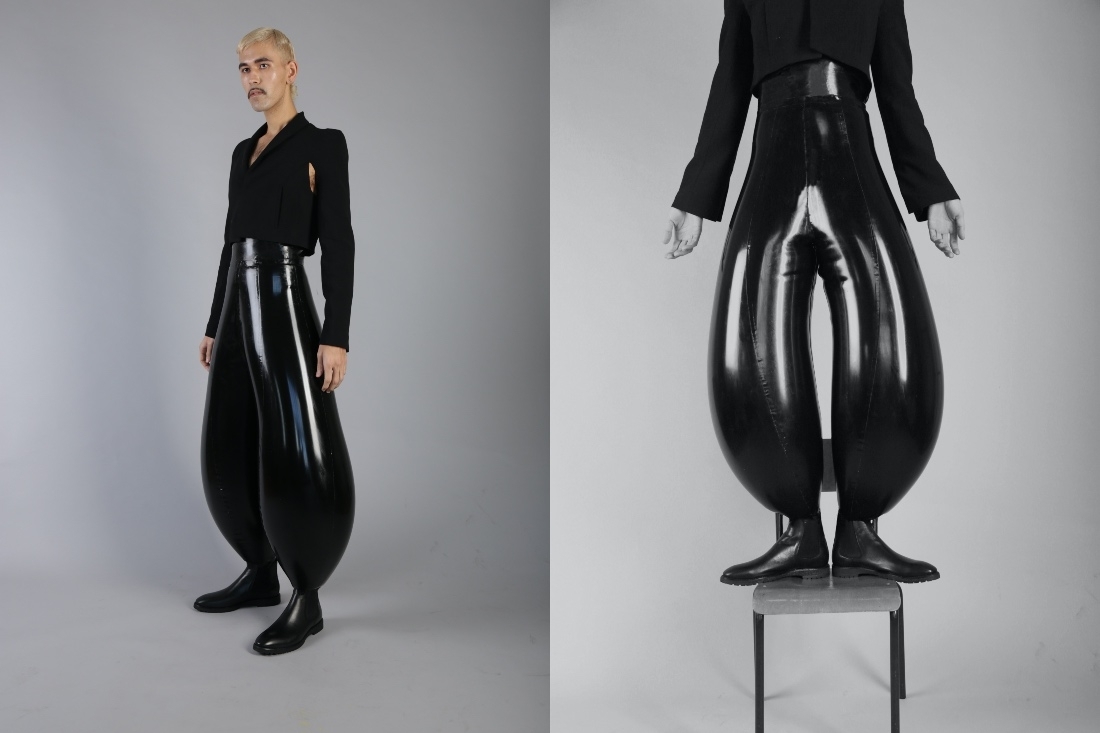

Athlete turned designer, Harikrishnan, grew up drawing on any possible surface he could find. He was merely ten years old when he was given an anatomical drawing book and this led to developing a taste for human anatomy sketches and nude study. What followed was a degree from NIFT during which he was introduced to competitive bodybuilding. His own body became a medium to imitate the proportions and physiques with which he had familiarised himself, over the years, sketching Gods and other figures. After quitting the competitive space he turned to fashion, a blank canvas that could be used to communicate his thoughts, the most fecund form of self expression. It was in 2017 that he enrolled at the London College of Fashion and his graduate collection had a smashing debut at the London Fashion A/W 2020.
Harikrishnan’s latex pants took social media by storm. They evoked an intense frenzy and curiosity about what they stood for. Were they arbitrary and would be lost in oblivion or were they constructed to create ripples through the discourse of fashion? While the collection was successful in evoking a rather visceral reaction from the audience, the shock value wasn’t intentional. “My intention from the inception of the design process was to create something which was not ‘visually neutral’ and could raise an instant dialogue among the audience. I took into account the visual impact while designing. I had this image in my head of a man put in a vase instead of a bunch of flowers.”
In a world where fleeting trends dominate, the collection exists as an antithesis to the mid 2000’s era of fashion, one which he considers as banal. “Each designer had a very strong identity from the 60s to 90s. The evolution was much stronger. However, by the mid-2000s due to pop culture, the Internet and later social media, the world of fashion became more accessible to the common man and thereby, was being influenced by him. Now people influence fashion. I wouldn’t say this is bad, but it diluted the industry to agreat extent and created this fear of acceptance among designers. Every designer wants to be accepted by the crowd, whereas when Margiela was designing clothes he wasn’t scared that his designs wouldn’t be accepted. Today fashion is dependent on music, film and celebrity endorsement. In that sense, I think my creations speak for themselves and have immense potential to translate into wearables.”
Harikrishnan only assembles those narratives that are born out of his lived reality. While in London, he was homesick and missed his pet dog. This pushed him to contemplate humanity from his dog’s perspective. “There was rigorous research on how different artists, from the stone age to photo age, studied and perceived human form and represented it through their respective mediums. What I think of as ‘human’ is not necessarily the other person’s ‘human’.” Hence the idea of multiple bodily perceptions hence formed the basis of his collection.
Another aspect of his life that dwelled in his design aesthetic were the Channapatna toys he grew up playing with as a child in South India. The beautiful round form and glossy texture persisted in his memory that led to the collaboration with the Channapatna, one of the oldest craft clusters in India. “For any curious mind studying sustainability, Channapatna is a model ecosystem. They don’t produce any waste in the process. It was also one of the most challenging parts for the collection. We took thirty days to produce what we wanted after a lot of trial and error. I had to make sure that we were on the same page mentally and emotionally which took some time.”

The designer further believes a complete reset of fashion post the pandemic, can only be possible through the consumers. “They are the key decisions makers.” On a personal front, his idea for the future of fashion is utopian. He is driven by a strong desire to build an ecosystem that thrives on collective effort and a strong artistic value. Making peace with the pandemic reality meant recognising the shared feeling of vulnerability. This has only strengthened his resolve and he is working on his next collection for Winter 2021.
This article was initially published in our November 2020 Bookazine. To read more grab your copy here.
Text Unnati Saini
Date 30-01-2021